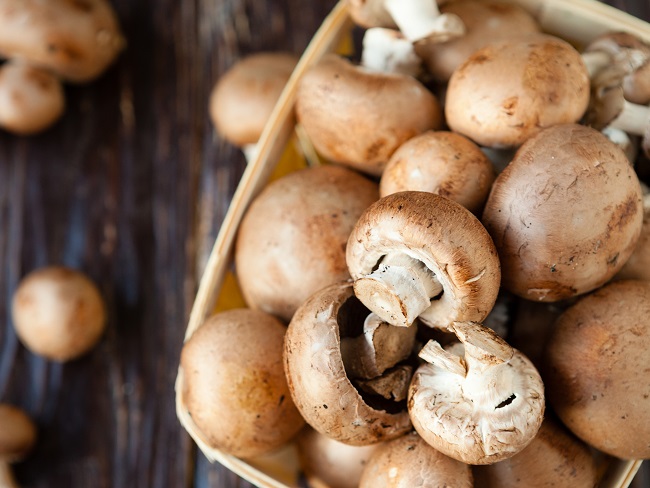A sustainable Thanksgiving
Plant-based recipes like this mushroom gravy are a delicious way to celebrate — and reduce your impact on the environment.
In November, many of us will celebrate Thanksgiving, often with friends and family gathered around the dinner table.
This time of year, with attention to those people who sustain us, we give thanks for health, happiness, and friendship. With so many people around the country celebrating and investing in the day, it also seems like as good a time as any to think about, and give back to, that which ultimately sustains us — our environment. It is a time of year when small changes by a large number of people can add up to a big impact.
Living in California, I’m thinking about water. Things we eat take a lot of water to produce. One pound of beef requires 1,800 gallons of water to produce and process (1). That’s equivalent to a 14-hour shower in the average American house (2). Poultry, such as chicken or turkey, requires less water, roughly 470 gallons per pound. Most fruits and vegetables require much less.
Consider a few of the following tips to make this year’s Thanksgiving your most sustainable yet.
- Lighten your bird. If you plan on roasting a turkey, try buying one that is a few pounds lighter than you normally purchase. This will allow you to reduce your water footprint, cook your bird in less time, and save you room for more fruits and vegetables (and, well, pie). Also, look for a bird that is organic and pasture-raised.
- Go meatless — or partially meatless. Some of you are probably planning on this already. If you like your roasted turkey, don’t fret. Go meatless with your side dishes. Check out the mushroom gravy below; it is an ode to umami that will supplant any sausage gravy.
- Buy local and organic when you can. Shop at your local farmers’ market for your produce and flowers. This will save on transportation energy costs and the produce, even if not certified organic, is more likely to be farmed in a sustainable manner. It will also help the farmer keep doing what he or she loves to do.
- Drink local. Tap water tastes good. Use a filter if you want. Drinking tap instead of bottled water will save a lot of plastic and chemicals from being used.
- Waste less. Save your vegetable scraps and make a vegetable stock. Compost what’s left. Stretch out your leftovers in fun and flavorful ways.
What are some other ways you plan on reducing your impact this Thanksgiving? Please share below. We’d love to hear them. Happy Thanksgiving!
References:
- National Geographic. The Hidden Water We Use.
- Home Water Works.
Mushroom Gravy
This recipe is a variation on one I found while looking for vegetarian Thanksgiving ideas. The combination of mushroom and soy is savory and delicious and will eliminate your desire for sausage or bacon in side dishes. It can be served over turkey, potatoes, biscuits, roasted squash, green beans, you name it.
Servings: 8
Ingredients
- 1 tablespoon extra-virgin olive oil
- 10 ounces cremini mushrooms, wiped clean, stemmed, and cut into thin slices
- 2 medium shallots, finely chopped
- 1 garlic clove, finely chopped
- 4 sage leaves, minced
- 2 sprigs thyme, leaves minced
- 1 to 2 tablespoons dry sherry (optional)
- 1/4 teaspoon red pepper flakes
- Scant 1/8 teaspoon ground clove
- 1 tablespoon low-sodium soy sauce
- 1 tablespoon maple syrup
- 1 tablespoon unsalted butter
- 1 tablespoon all-purpose flour
- 1 1/4 cups whole or reduced-fat milk
- Zest and juice of 1/2 small lemon
Directions
- Heat a sauté pan over medium heat and add the olive oil. When hot, add the mushrooms and cook until softened and starting to brown, about 2 to 3 minutes.
- Add shallots and garlic to the mushrooms. Stir to combine.
- When the shallots are translucent and softened, add the sage, thyme, and sherry, if using, and cook until the liquid is almost evaporated.
- Pour the mushroom mixture into the bowl of a food processor and add the red pepper flakes, clove, soy sauce, and maple syrup. Pulse to combine.
- Place the pan back over medium heat and add the butter.
- After it melts and the foaming subsides, add the flour and stir constantly until the roux (butter plus flour) is lightly brown and fragrant, about 3 to 4 minutes.
- Add the milk slowly, whisking to combine. The mixture may look clumpy at first but keep whisking until smooth. Heat until the edges are bubbling and the mixture thickens slightly.
- Pour milk mixture into the food processor and pulse until well combined.
- Add the lemon zest and juice and pulse some more. A slightly chunky texture is good. Taste and adjust seasoning with salt or lemon juice as needed.
- Return mushroom gravy to the pan over low heat and keep warm until ready to serve.
Nutrition information (per serving)
- Calories: 70
- Total fat: 4 g
- Saturated fat: 1.5 g
- Cholesterol: 5 mg
- Sodium: 20 mg
- Total carbohydrate: 8 g
- Dietary fiber: 0 g
- Total sugars: 4 g
- Protein: 3 g
Note: Does not include added salt.
